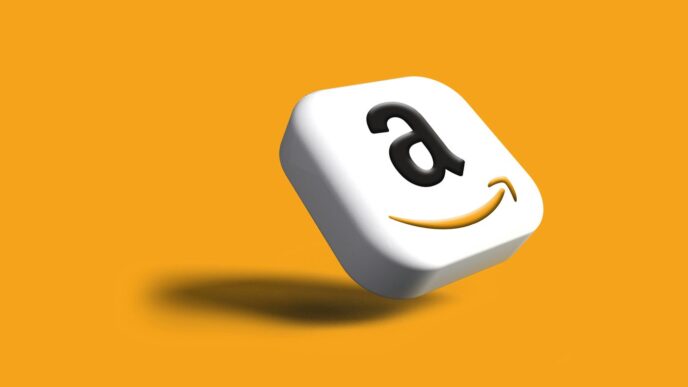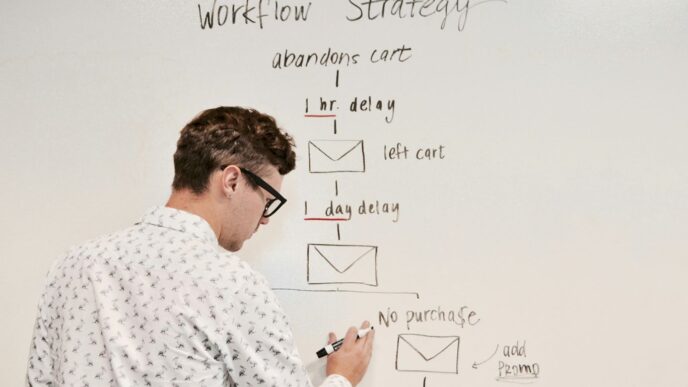Starting a business is thrilling, but figuring out how to market it can feel overwhelming. You might have a fantastic product or service, but if people don’t know about it, success will be hard to come by. That’s where effective marketing comes in. In this article, we’ll share ten practical entrepreneur marketing tips that can help you get your business noticed and boost your chances of success.
Key Takeaways
- Having a solid website is essential for establishing your online presence.
- Engaging with customers through social media can create lasting relationships.
- Email marketing is a cost-effective way to reach your audience directly.
1. Register a Web Domain and Invest in Creating a Website
Okay, so you’re starting a business. Awesome! Where do you even begin with marketing? Well, a website is often the first place to start. I know, I know, it sounds basic, but trust me, it’s still super important. Some businesses might get by with just social media, but that’s pretty rare. You need a place online where people can find out about you, what you sell, and why they should care. Think of it as your digital storefront. It’s where you tell your brand story.
- Get a domain name: This is your address on the internet. Make it something easy to remember and related to your business. Don’t overthink it, but do make sure it’s available!
- Choose a website builder: There are tons of options out there, from super simple drag-and-drop builders to more complex platforms. If you’re not a tech whiz, stick with something user-friendly. There are tools perfect for entrepreneurs looking to build their first websites but don’t have the programming experience for the task.
- Make it fast and easy to use: No one wants to wait for a website to load, and they definitely don’t want to wade through a bunch of confusing information. Keep it simple, clear, and focused on what your customers need to know. You want to optimize your keyword listings so your audience can find your website easily.
It might cost a bit of money, but it’s worth it. A good website lets you focus on running your business instead of wrestling with code. Plus, it makes you look way more professional. It’s a win-win!
2. Leverage Content Marketing for Brand Authority
Okay, so content marketing. It’s not just about throwing words onto a page; it’s about showing people you know your stuff. It’s about building trust, one blog post, one video, one whatever-you-create at a time. Think of it as proving you’re the real deal before anyone even thinks about buying from you. It’s a long game, but it pays off.
- Consistent, Quality Content: You can’t just post anything. It needs to be good, like actually helpful or interesting. And you need to do it regularly. I know, easier said than done, but that’s the key. Think blog posts, videos, infographics – whatever fits your brand. Make sure your marketing strategy is on point.
- Solve Problems: What are your customers struggling with? Answer those questions. Give them solutions. Show them you understand their pain points. That’s how you become a go-to resource.
- Authority Blogging: Don’t just stick to your own site. Branch out. Post on Medium, answer questions on Quora, get on LinkedIn. These platforms already have huge audiences. It’s like borrowing their spotlight.
- SEO is your friend: Make sure people can find your content. Learn the basics of SEO. Use keywords, optimize your titles and descriptions. It’s not rocket science, but it makes a difference. You want to make sure you are posting your ideas where people can see them.
3. Grow and Connect with Customers
Okay, so you’ve got some customers. Great! Now what? It’s not enough to just make a sale and then disappear. You need to actually, you know, connect with these people. Think of it like this: would you rather have a one-time buyer or someone who keeps coming back and tells all their friends about you? I’m guessing the second one, right? Building relationships is key. It’s about making them feel valued, heard, and like they’re part of something bigger than just a transaction. It’s about building your brand awareness.
Here’s a few things I’ve found helpful:
- Personalize the Experience: Nobody likes feeling like just another number. Use their name in emails, remember their past purchases, and tailor your communication to their interests. It shows you’re paying attention. I mean, who doesn’t like a little customer experience?
- Be Responsive: Seriously, answer their questions and address their concerns quickly. Nothing is more frustrating than being ignored when you have a problem. Social media is great for this, but make sure you’re actually monitoring it.
- Ask for Feedback: Find out what they like and what they don’t like. Use surveys, polls, or just plain old conversations. This is how you improve your referral program and make sure you’re actually giving them what they want. Plus, it shows you care about their opinion.
- Show Your Human Side: People connect with people, not faceless corporations. Share your story, your values, and even your mistakes. Authenticity goes a long way. Don’t be afraid to let your personality shine through. It’s about mirroring your marketing products with your personality.
- Create a Community: Give your customers a place to connect with each other. This could be a Facebook group, a forum, or even just a regular meetup. When customers feel like they’re part of a community, they’re more likely to stick around.
4. Advertise on Facebook
Facebook ads? Yeah, they can be a game-changer. I remember when I first started using them, I was totally lost. But once I figured out the targeting, things started to click. You can really narrow down who sees your ads based on stuff like age, interests, and even where they live. It’s pretty wild.
Here’s the thing, though: it’s not just about getting people to click. You need to think about what happens after the click. Are they actually buying something or signing up for your email list? That’s where the Facebook Pixel comes in. Seriously, if you don’t know how to use it, learn it now. It tracks who visits your site, so you can show them more ads later. It’s like saying, "Hey, remember that thing you looked at? Here it is again!"
I’ve seen some businesses really take off because they got good at Facebook ads. One local bakery started running ads showing off their cakes, and suddenly, they were swamped with orders. Another friend who sells sizzling sales copy online courses used Facebook ads to target people interested in marketing, and his sales went through the roof. It’s all about finding the right audience and showing them something they actually want.
And don’t be afraid to try different kinds of ads. Video ads can be super effective, but so can just a simple image with some catchy text. The key is to test, test, test. See what works best for your business and your audience. It might take some time to figure it out, but it’s worth it in the end.
5. Your Email Marketing Effort Starts Now

Okay, so email marketing. It might seem a little old-school, but trust me, it’s still a powerhouse. I think a lot of people overlook it because they’re too busy chasing the latest social media trends, but email is direct, personal, and super effective if you do it right. Plus, almost everyone has an email address, right? It’s way more universal than any single social platform. Let’s get into it.
Think of email marketing as your direct line to your audience. Unlike social media, where your posts are at the mercy of algorithms, email lets you land right in their inbox. It’s a chance to deliver personalized content and build real relationships. But here’s the thing: you can’t just blast out generic messages and expect results. You need a strategy.
Here’s what I’ve learned about making email marketing work:
- Build Your Own List: Seriously, don’t buy email lists. It’s tempting, I know, but it’s a waste of money and can get you marked as spam. Instead, focus on building your own list organically. Offer something valuable in exchange for email sign-ups – a free e-book, a discount code, exclusive content. Make it worth their while.
- Segment, Segment, Segment: Not everyone on your list is the same. Segment your audience based on their interests, behavior, or demographics. This lets you send targeted emails that are more relevant and engaging. For example, if someone downloaded a guide on gardening, send them emails about gardening tips and products. It’s all about delivering value.
- Automate (But Be Human): Set up automated email sequences for things like welcome emails, abandoned cart reminders, and post-purchase follow-ups. But don’t let them sound robotic. Personalize them with the recipient’s name and make sure the tone is conversational. No one wants to feel like they’re talking to a machine. You can use an email service provider to help with this.
Email marketing isn’t just about selling. It’s about building trust, providing value, and nurturing relationships. Do it right, and it can be one of your most effective marketing tools.
6. Partner with Influencers

Influencer partnerships? Yeah, they can seriously boost your business. It’s all about finding the right people to promote your brand. Think of it as borrowing someone else’s megaphone – but you gotta make sure they’re speaking to your crowd.
Here’s the deal. It’s not just about finding someone with a million followers. Sometimes, those micro-influencers – the ones with a smaller, but super-engaged audience – can be way more effective. They often have a more authentic connection with their followers, which translates to more trust and, ultimately, more sales for you.
Think about it:
- Find your niche: You need to find influencers who are actually relevant to your product or service. If you’re selling organic dog treats, partnering with a fitness influencer probably isn’t the best move. Look for pet lovers, dog trainers, or even vets who have a strong online presence.
- Check their vibe: Make sure their values align with your brand. You don’t want to partner with someone who’s constantly posting controversial stuff if your brand is all about positivity and inclusivity.
- Engagement is key: Don’t just look at follower count. Check their engagement rate. Are people actually liking, commenting, and sharing their content? A high follower count with low engagement is a red flag.
It’s like, if you’ve got a solid product and a clear offer, getting an influencer on board can be the perfect way to increase brand awareness. Just do your homework, find the right fit, and watch your business grow.
7. Invest in Referral Programs
Word-of-mouth marketing? Still a big deal. People trust recommendations from friends way more than ads. So, how do you get people talking? Referral programs! They’re not just a nice-to-have; they can seriously boost your business. Think of it as turning your happy customers into your sales team. It’s like, "Hey, tell your friends, and get something cool!"
Here’s the thing: you can’t just hope people will refer you. You gotta give them a reason. Incentives are key. People need a little nudge, something that makes them think, "Yeah, I should totally tell my friends about this." Plus, make it super easy for them to share. No one wants to jump through hoops just to recommend something. Let’s look at some ways to encourage customer referrals.
Here are some ideas for incentives:
- Discounts: Everyone loves a good discount. Offer a percentage off their next purchase for every successful referral.
- Freebies: Who can say no to free stuff? A free product, a free month of service – it’s a great way to get people excited.
- Gift Cards: Let your customers choose what they want. A gift card to your store or a popular retailer is always a winner.
Referral programs can really help you get new customers without spending a ton on ads. It’s all about making your current customers happy and giving them a reason to spread the word. It’s a win-win!
8. Utilize Social Media Effectively
Okay, so you know you should be on social media, but actually making it work for your business? That’s the tricky part. It’s not just about posting; it’s about being smart. Think of it as more than just a place to shout about your product. It’s a place to connect, build relationships, and show people what you’re all about.
First things first, figure out where your audience actually is. Don’t spread yourself too thin trying to be everywhere at once. Are they on TikTok, scrolling through Instagram, or networking on LinkedIn? Once you know that, you can tailor your content to fit the platform and what people expect to see there. For example, you might share company culture posts on LinkedIn, while product features might be better suited for Instagram.
Here’s a few things to keep in mind:
- Be Human: Nobody wants to follow a robot. Seriously, with all the AI stuff going on, people crave authenticity. Inject some personality into your posts and comments. Let people see the real you (or the real people behind your brand).
- Offer Value: Don’t just sell, sell, sell. Share useful information, answer questions, and provide resources. Think of your social media as a place to build brand awareness by sharing valuable content that resonates with your audience.
- Be Consistent: Algorithms love consistency. Post regularly, even if it’s just a few times a week. It keeps you top of mind and shows you’re serious.
- Engage: Social media is a two-way street. Respond to comments, answer questions, and participate in conversations. Show people you’re listening.
It’s easy to get caught up in the numbers, but remember that social media is about building relationships. Focus on creating genuine connections, and the rest will follow. And don’t be afraid to experiment! See what works for your audience and adjust your strategy accordingly. It’s all about learning and growing.
9. Create Engaging Video Content
Video content is where it’s at these days. People love watching videos, and it’s a super effective way to get your message across. Think about it: you can show off your products, share customer stories, or just give people some useful info. Plus, it doesn’t have to be super fancy to work. Here’s how to make the most of it:
- Show, don’t just tell: Got a product with cool features? A video lets you demonstrate exactly how it works. It’s way more engaging than just reading about it. Think tutorials, product demos, or even just a quick peek behind the scenes.
- YouTube is your friend: Seriously, it’s the second-biggest search engine. People go there to find answers and solutions. Create videos that solve problems for your audience, and you’ll boost your visibility in no time. Don’t forget to monetize your videos to make some extra income.
- Don’t be afraid of TikTok: It’s huge! Your audience is probably already there. Short, fun videos can go a long way in grabbing attention and driving traffic. Consider creating a company TikTok channel to reach a wider audience.
- Repurpose, repurpose, repurpose: Turn your videos into blog posts, social media snippets, or even email content. Get the most mileage out of every video you create. This helps increase website visitors and engagement.
Video marketing doesn’t have to break the bank. All you need is a good idea, a camera (your phone works fine!), and some basic editing skills. Get creative and start making videos that connect with your audience.
10. Run Time-Sensitive Promotions and Contests
Okay, so you want to get people excited and maybe light a fire under them to actually buy something? Time-sensitive promotions and contests are your friend. Seriously, creating a sense of urgency can do wonders for your sales. It’s like, "Buy now or miss out forever!" – people respond to that.
Think about it, everyone loves a good deal, and the fear of missing out (FOMO) is real. Here’s how to make it work:
- Flash Sales: These are super short sales, like a few hours or a day. Announce it everywhere – social media, email, your website. Make it a big deal. People love feeling like they snagged something special.
- Limited-Time Discounts: Offer a discount that expires. It could be a percentage off, free shipping, or a bonus gift. The key is the ticking clock. "20% off until midnight!"
- Contests and Giveaways: Who doesn’t love free stuff? Run a contest on social media. Ask people to like, share, and tag friends to enter. It gets your brand out there and builds excitement. Just make sure the prize is something people actually want.
Promote these like crazy. Use all your channels. Get the word out. The more people who know, the better. And track everything! See what works, what doesn’t, and adjust for next time. It’s all about experimenting and finding what gets your customers clicking that buy button.
Running special promotions and contests can really grab attention and boost excitement around your brand. These time-limited events encourage people to act quickly, making them feel like they might miss out if they don’t join in. Want to learn more about how to create effective promotions? Visit our website for tips and ideas!
Wrapping It Up
So there you have it—ten marketing tips that can really help your business take off. It might feel overwhelming at first, but remember, every big success starts with small steps. Whether it’s building a website, using social media, or starting an email list, just pick one or two to focus on first. Don’t be afraid to experiment and see what works best for you. And hey, if something doesn’t go as planned, that’s okay too! Learn from it and keep moving forward. The key is to stay consistent and keep your customers in mind. With time and effort, you’ll see your business grow. Good luck out there!














